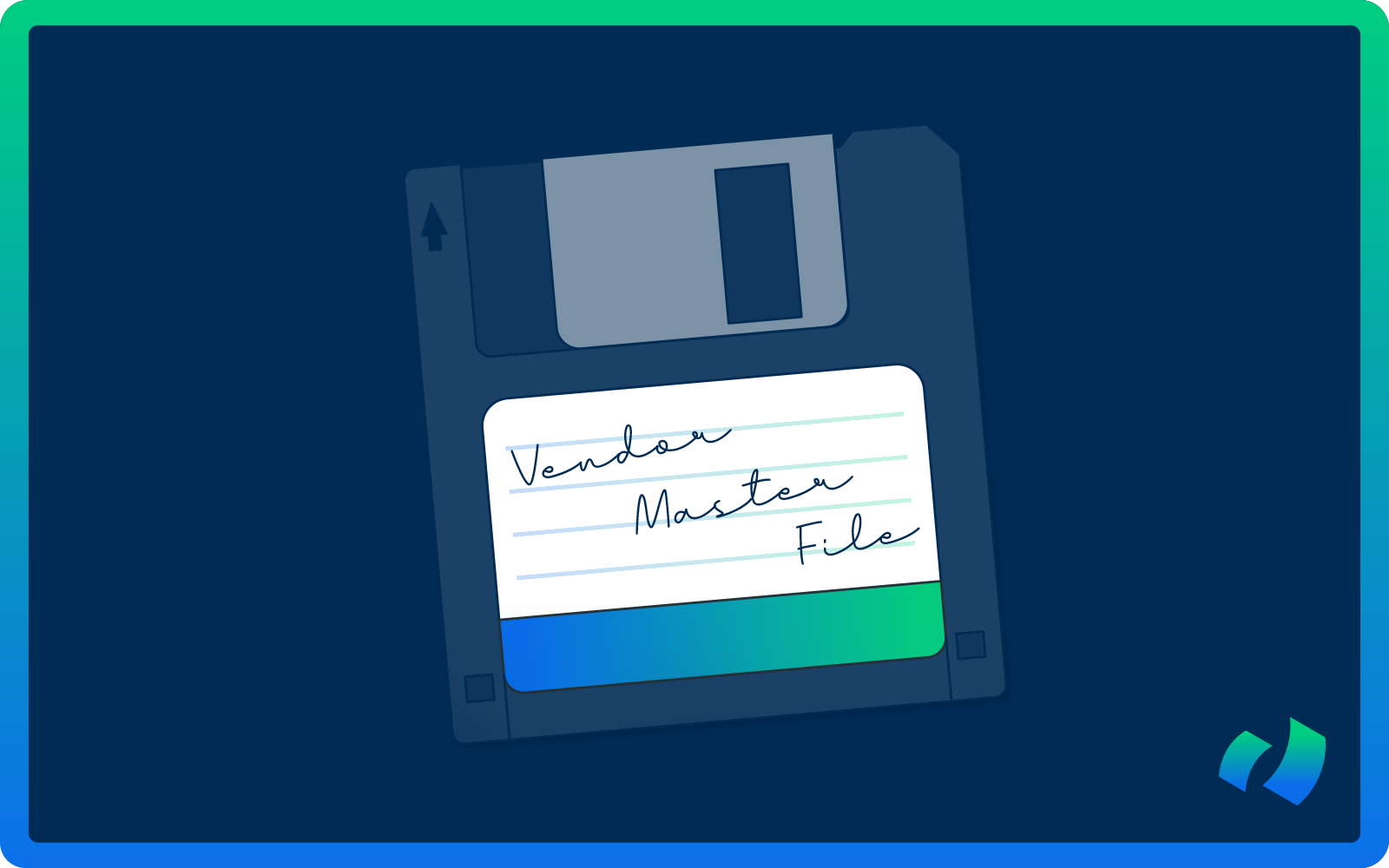Vendor relationships are the backbone of any successful business, providing the essential goods and services that keep operations running smoothly. Whether it’s raw materials, technology, or other critical supplies, vendors play a crucial role in enabling a company to produce its products or deliver top-notch services. That’s why nurturing these relationships should always be a top priority.
At the core of effective vendor management lies something that often flies under the radar – the vendor master file (VMF). This database is more than just a list of contacts; it’s a vital repository of detailed information about every vendor a company works with, serving as the foundation for smooth and efficient operations.
In today’s blog post, we’ll explore why maintaining an accurate and up-to-date vendor master file is so essential.
We’ll share best practices for organizing and updating this critical resource, and discuss how leveraging technology can enhance efficiency and reduce the risk of costly mistakes. We’ll also cover strategies for mitigating risks associated with VMF errors, ensuring your business keeps running without a hitch.
Ready to get started? Let’s dive in.
What Is a Vendor Master File?
A vendor master file (VMF), also known as a supplier master file, is a comprehensive record of all the vendors or suppliers a company does business with. This database includes contact details, payment terms, contract agreements, and other critical data that help manage the relationship between a company and its vendors.
The vendor master file serves as a centralized repository for all vendor-related data and is used by various departments within an organization, including procurement, finance, and accounting. It streamlines processes related to vendor management and enables better decision-making through accurate and up-to-date information.
Proper management of vendor master files is important because it ensures timely payments to vendors, reduces errors in transactions, maintains compliance with regulatory requirements, and minimizes risks such as fraud or duplicate payments.
6 Best Practices for Managing Vendor Master File
A well-maintained vendor master file not only ensures accurate vendor information but also fosters stronger vendor relationships and enhances overall business efficiency. By implementing consistent processes for data entry, conducting regular audits, and leveraging technology, companies can significantly improve their vendor management practices.
Let’s explore the essential strategies and best practices that will help you create and sustain an optimal VMF, setting the stage for seamless operations and informed decision-making.
- Establish a Standardized Process for Data Entry
- Keep Your Vendor Master Files Organized and Clean
- Implement a Robust Data Security Framework
- Utilize Technology for Enhanced Efficiency
- Define Clear Policies and Procedures
- Monitor Vendor Performance
1) Establish a Standardized Process for Data Entry
Effective management of vendor master files starts with a standardized approach to data entry. This ensures that all vendor-related data is accurate and consistently formatted.
A uniform data entry process helps avoid discrepancies and ensures that all necessary information is captured in a reliable manner.
Creating a Standardized Process:
- Consistency across teams: Implement a uniform data entry process across all departments. This includes contact information, banking details, contracts, and payment terms. Consistent data entry formats help in integrating VMF data seamlessly with other systems, such as accounts payable automation tools, facilitating a smoother flow of information.
- Designated personnel: Assign specific individuals or teams responsible for maintaining the VMF. This helps in avoiding gaps or inconsistencies in the data. Designating clear responsibilities also ensures that updates and corrections are handled promptly, reducing the likelihood of errors or delays.
- Regular training: Conduct ongoing training for employees on the importance of accurate data entry. Training should also cover how to use any automated systems integrated with the VMF, which further reduces manual errors and enhances data reliability.
2) Keep Your Vendor Master Files Organized and Clean
Maintaining an organized and clean vendor master file is essential for efficient management and smooth operations. Proper organization ensures that vendor data is easily accessible and manageable, which is critical for both daily operations and strategic decision-making.
Organizing Your Vendor Master Files:
- Consistent naming conventions: Use a consistent format for naming vendors. For example, you might use the vendor’s full name followed by a unique identifier or abbreviation. This approach minimizes confusion and maintains uniformity across records, making data retrieval more straightforward.
- Categorization: Group vendors by common factors such as the products or services they provide, their geographical location, or payment terms. Categorization simplifies information retrieval and enhances the efficiency of vendor management, helping in quick decision-making.
- Regular maintenance: Schedule regular reviews and updates of your vendor master file to ensure data accuracy. This practice helps prevent issues like payments being sent to outdated or incorrect vendors. Automated accounts payable software can assist in flagging discrepancies and ensuring timely updates.
Cleaning Your Master Vendor File:
- Review the current state: Begin by assessing the current condition of your vendor master file to identify existing issues and areas needing improvement. Understanding the current state helps prioritize which areas require immediate attention and helps plan corrective actions effectively.
- Define data standards: As mentioned before, establish clear standards for data entry and maintenance. Consistent data standards ensure the accuracy and reliability of records. Adhering to these standards also facilitates smoother integration with automated systems and reporting tools, enhancing overall efficiency.
- Identify and merge duplicates: Use automated tools or manual processes to detect and merge duplicate records. This keeps your data streamlined and accurate, reducing the risk of errors in payment processing and vendor communications.
- Update outdated information: Regularly update vendor information such as contact details, payment terms, and pricing agreements to reflect current data. Timely updates are crucial for maintaining accuracy and efficiency, especially when integrated with automated payment systems that handle transactions.
- Periodic audits: Schedule regular audits of your vendor master file to identify and correct any new duplicates or errors. Periodic reviews help maintain data integrity and ensure that your automated systems operate with the most accurate information available.
3) Implement a Robust Data Security Framework
Securing sensitive information within your vendor master file is crucial for protecting against unauthorized access, data breaches, and fraud. A robust data security framework helps mitigate risks and ensures compliance with regulatory requirements.
Enhancing Data Security:
- Access controls: Restrict access to the vendor master file based on roles and responsibilities. Only authorized personnel should be able to view or edit sensitive information. Implementing strict access controls minimizes the risk of unauthorized alterations and potential security breaches.
- Encryption: Encrypt sensitive data both at rest and in transit to ensure it remains secure even if intercepted or accessed without authorization. Encryption adds an additional layer of protection against data breaches and cyber threats, maintaining the confidentiality of your data.
- Regular backups: Perform regular backups of your vendor master file to prevent data loss due to system failures or cyber-attacks. Ensure that backups are securely stored and easily accessible for recovery, which is vital for maintaining business continuity in the event of a data loss incident.
- Audit trails: Maintain detailed logs of all changes made to the vendor master file. Audit trails help track who accessed or modified data and are essential for addressing potential security issues and ensuring accountability. They also assist in forensic investigations if a data breach occurs.
- Employee training: Educate employees on data security best practices and the importance of protecting sensitive information. Regular training helps mitigate the risk of human error leading to security breaches, especially when dealing with automated systems that manage sensitive data.
4) Utilize Technology for Enhanced Efficiency
Technology can greatly improve the management of vendor master files by automating processes, reducing errors, and increasing efficiency. Incorporating advanced technological solutions streamlines operations and integrates seamlessly with other business systems.
Utilizing Technological Solutions:
- Vendor management software: Invest in a dedicated Vendor Management Software (VMS) that centralizes vendor information, automates workflows, and provides real-time updates. A VMS enhances data entry efficiency, ensures compliance, and improves communication with vendors. Integration with accounts payable automation systems can further streamline payment processes and reduce manual intervention.
- Data integration: Integrate your VMF with other business systems, such as ERP (Enterprise Resource Planning) and accounting software. This integration ensures consistency across platforms and reduces the need for manual data entry, facilitating seamless operations and better financial management.
- Automated validation: Implement automated validation tools to verify the accuracy of vendor information during entry. These tools can check for errors, duplicate entries, and compliance with data standards, minimizing manual errors and improving overall data quality.
- Digital signatures: Use digital signatures to streamline contract management and verify the authenticity of agreements. Digital signatures provide a secure and efficient method for handling contracts and approvals, which can be integrated with automated systems for enhanced efficiency and compliance.
5) Define Clear Policies and Procedures
Clear policies and procedures are vital for maintaining consistency in managing vendor master files. Well-defined guidelines ensure that all aspects of vendor management are handled systematically and effectively.
Key Elements to Include:
- Data entry guidelines: Define the format and standards for entering vendor information, including required fields and data validation rules.
- Vendor onboarding process: Outline the steps for onboarding new vendors, including the collection of necessary documentation, verification of information, and approval procedures. A structured onboarding process helps integrate new vendors smoothly and efficiently, ensuring they meet all requirements before becoming active.
- Change management: Establish protocols for updating vendor information, including who is authorized to make changes and how these changes are documented. Proper change management procedures ensure that updates are handled systematically and recorded accurately, minimizing the risk of errors.
- Compliance and auditing: Detail procedures for ensuring compliance with relevant regulations and conducting regular audits of the vendor master file. Regular audits help maintain compliance and identify potential issues before they become significant problems, ensuring adherence to legal and regulatory requirements.
6) Monitor Vendor Performance
Effective vendor management involves actively monitoring and assessing vendor performance to ensure that vendors meet their obligations and deliver value. Regular evaluations help maintain strong vendor relationships and optimize performance.
Practices for Monitoring Vendor Performance:
- Performance metrics: Define clear metrics and key performance indicators (KPIs) for evaluating vendor performance. Metrics might include delivery times, product quality, and customer service. These benchmarks provide a basis for assessing vendor effectiveness and identifying areas for improvement.
- Feedback mechanisms: Implement systems for gathering feedback from internal stakeholders who interact with vendors. This feedback provides valuable insights into vendor performance and can highlight areas for improvement or adjustment, leading to better vendor relationships.
- Regular reviews: Conduct regular performance reviews with vendors to discuss performance, address issues, and explore opportunities for improvement or collaboration. Ongoing communication fosters stronger relationships and ensures that both parties remain aligned on expectations.
- Contract management: Monitor adherence to contract terms and conditions. Address any discrepancies or issues promptly to maintain strong vendor relationships and ensure compliance. Automated systems can assist in tracking contract compliance and managing renewals efficiently.
Revolutionize Your Vendor Master File Management with DOKKA
DOKKA can be a valuable tool for managing your vendor master file by leveraging its automation and integration capabilities to streamline the management of vendor-related information.
Here’s how DOKKA can help:
Automated Data Extraction
- Efficiency: DOKKA automates the extraction of vendor data from invoices and documents, reducing the need for manual data entry.
- Accuracy: By leveraging Optical Character Recognition (OCR) and advanced data extraction technologies, DOKKA ensures that vendor information is accurately captured and inputted into your VMF.
Seamless Integration
- Centralized Management: DOKKA integrates with existing accounting and ERP systems, such as NetSuite, Microsoft Dynamics and SAP Business One, to ensure that vendor information in the VMF is consistent across all platforms.
- Real-time Updates: Integration with your financial systems allows for real-time updates to vendor records, reducing the risk of discrepancies and keeping your VMF current.
Data Validation and Standardization
- Consistency: DOKKA applies validation rules and standardization processes to ensure that vendor data conforms to required formats and standards.
- Error Reduction: Automated validation helps to minimize errors and inconsistencies in vendor records, enhancing the overall quality of the VMF.
Enhanced Document Management
- Document Storage: DOKKA provides a centralized repository for all vendor-related documents, including contracts, invoices, and correspondence.
- Easy Retrieval: With robust search and retrieval features, you can quickly access and review vendor documents as needed, improving operational efficiency.
Streamlined Invoice Processing
- Automated Workflow: DOKKA streamlines the invoice approval and payment processes, reducing the time and effort required to process vendor invoices.
Improved Compliance and Reporting
- Regulatory Compliance: DOKKA helps ensure that your vendor data management practices comply with relevant regulations and industry standards.
- Comprehensive Reporting: Generate detailed reports on vendor activities, transactions, and compliance, providing valuable insights for decision-making and audits.
Enhanced Security
- Data Protection: DOKKA employs robust security measures to protect sensitive vendor information, including encryption and access controls.
- Audit Trails: Maintain detailed records of data changes and user actions, which can be crucial for auditing and ensuring data integrity.
Vendor master file management is crucial for any business. By establishing clear processes and utilizing automation tools like DOKKA, you can streamline your VMF management and reap significant operational benefits.
A well-managed vendor master file not only boosts efficiency but also reduces errors and mitigates risks, ultimately driving success in a competitive business environment. Leveraging DOKKA’s capabilities can greatly enhance the efficiency, accuracy, and security of your vendor master file management.
Want to learn how? Book a demo call with our team today to discover the details!








